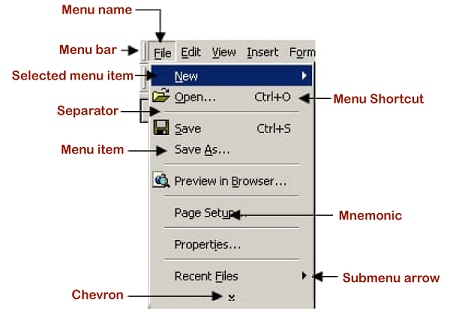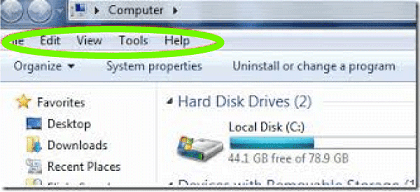What is a Menu Bar?
A menu bar is a graphical user interface element typically located at the top of a computer screen or window. It provides access to various commands and options within an application or operating system. The menu bar typically contains a series of menus, each containing a series of commands or options.

The menu bar is a standard feature of most modern operating systems and applications. In Windows, the menu bar is typically located at the top of the screen, while in MacOS, it is located at the top of the screen and is referred to as the "Apple menu." In Linux, the menu bar is typically located at the screen's top and referred to as the "panel."
The menu bar is an essential user interface element, providing quick access to commonly used commands and options. For example, the "File" menu typically contains options for opening, saving, and printing files, while the "Edit" menu typically contains options for cutting, copying, and pasting text. Many applications also include a "Help" menu that provides access to documentation and support resources.
Uses of the Menu bar
- Quick access to commonly used commands and options within an application or operating system.
- Navigation through different menus, each of which contains a series of commands or options.
- The standard feature of most modern operating systems and applications.
- Provides options for opening, saving, and printing files in the "File" menu.
- Provides options for cutting, copying, and pasting text in the "Edit" menu.
- Provides access to documentation and support resources in the "Help" menu.
- Displays context-sensitive menus when the user right-clicks on an object or area within the application or operating system.
- Provides relevant options to the object or area the user has clicked on through context-sensitive menus.
- Allows for efficient navigation and organization of different applications or operating system features.
- Enhances user experience by making it easier to access important functions and settings.

Advantages of the Menu bar
- Efficient navigation: The menu bar allows users to quickly and easily access various commands and options within an application or operating system. This improves the overall efficiency of the user experience.
- Organized access to features: The menu bar organizes different features of an application or operating system into different menus, making it easy for users to find what they need.
- Context-sensitive options: The menu bar also provides context-sensitive options relevant to the object or area the user has clicked on. This improves the user experience by providing the user with options that are most relevant to the task at hand.
- Consistency: The menu bar is a standard feature of most modern operating systems and applications, making it a familiar and consistent user interface element for users across different applications and systems.
- Access to support and documentation: The menu bar usually includes a "Help" menu that provides users with access to documentation and support resources, making it easy to find answers to questions or troubleshoot issues.
- Customizable: Some applications allow users to customize their menu bar, which allows them to add or remove commands and options that they use most often.
- Improved productivity: The menu bar allows users to perform tasks quickly and efficiently, improving overall productivity.
- Enhances Discoverability: The menu bar makes it easy for users to discover new features and options they may not have previously known.
Disadvantages of Menu Toolbar
- Cluttered interface: Multiple menu options in the menu bar can become cluttered and overwhelming for some users.
- Limited screen space: The menu bar takes up valuable screen space, which can be an issue for users with smaller screens or who need more screen real estate for other tasks.
- Limited discoverability: Users may need to be made aware of all the options and commands available in the menu bar, which can limit the discoverability of features.
- Limited customization: While some applications allow users to customize their menu bar, many still need to, which can limit users' ability to tailor the interface to their needs.
- Inefficient for power users: For users who frequently use a specific set of commands and options, the menu bar may not be the most efficient way to access them, as they would need to navigate through multiple menus to find what they need.
- Lack of standardization: Different applications and operating systems may have different menu bar layouts, which can confuse users who switch between them.
- Limited accessibility: Menu bars can be difficult for users with certain disabilities, such as visual impairments, to navigate.
- Outdated: With more modern interface options, such as ribbon and icon-based interfaces, the menu bar may need to be updated for some users.
Tips for using
Learn the keyboard shortcuts: Many commands and options in the menu bar have associated keyboard shortcuts, which can make it faster and more efficient to access them. Make sure to learn and memorize the keyboard shortcuts for the commands and options you use most often.
Customize the menu bar: This can make it easier to access the features you need.
Use the search function: If the menu bar has a search function, quickly find commands and options within the application or operating system.
Utilize context-sensitive options: Take advantage of context-sensitive options relevant to the object or area you have clicked on. This can help you access the options that are most relevant to the task at hand.
Organize your recent files: Some menu bars display the recent files that have been opened. Keep track and organize your recent files so you can quickly access them.
Use the "Help" menu: If you have questions or issues, check the "Help" menu for documentation and support resources.
Check for updates: Make sure to check for updates to the application or operating system through the menu bar, as this can ensure that you are running the latest version and have access to new features and bug fixes.
Personalize your experience: If the menu bar allows for customization in terms of color and theme, take advantage of this option to personalize your interface according to your preference.
Take advantage of settings and preferences: Make sure to explore the settings and preferences options in the menu bar, as this can allow you to adjust various settings and options within the application or operating system to suit your needs.
Be consistent: Try to use the same applications and operating systems as much as possible to become familiar with their menu bar layout and navigation, improving your overall efficiency and productivity.
Summary
The menu bar is a graphical user interface element typically located at the top of a computer screen or window and provides access to various commands and options within an application or operating system. It is a standard feature of most modern operating systems and applications. It is an essential user interface element that provides quick access to commonly used commands and options. The menu bar organizes different features of an application or operating system into different menus, making it easy for users to find what they need. It also provides context-sensitive options relevant to the object or area the user has clicked on. However, the menu bar can also have disadvantages, such as cluttering the interface, taking up valuable screen space, and needing to be clearer for power users.